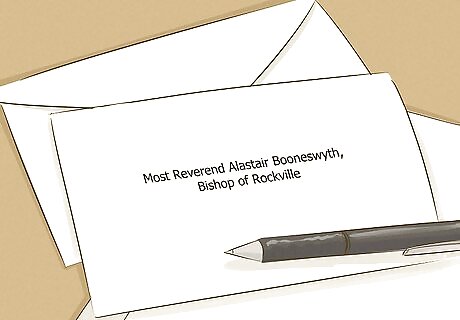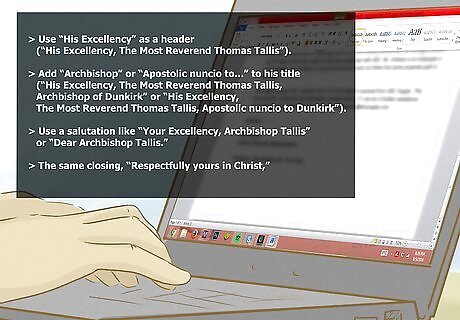
views
Writing to a Bishop

Address them as "Most Reverend" followed by their full name. When writing to a bishop, you’ll want to use the most formal mode of address. Church etiquette dictates that you should use the form “Most Reverend,” followed by the bishop’s first name and last name. For instance, if you are writing to bishop Alastair Booneswyth, the header of your letter should read “Most Reverend Alastair Booneswyth.” In Great Britain, it is common to refer to Bishops as "The Right Reverend."

Follow the formal address with their title and parish name. Include the word "bishop," and then write their location. Write this out on the envelope when you address it, and also use it as a header at the top of the letter itself. When you're done, it should look something like: ”Most Reverend Alastair Booneswyth, Bishop of Rockville.”

Include a polite salutation. When writing to them you should use a proper greeting. “Your Excellency” will always work, but if you know the bishop personally, you can also greet them with “Dear…” Follow the salutation with the bishops’ last name. For instance, either “Your Excellency, Bishop Booneswyth” or “Dear Bishop Booneswyth” can work, depending on how well you know the bishop.

Conclude the letter with a graceful closing. The phrase “Respectfully yours in Christ” will work in any case. Add this to the end of your letter, then sign your name.

Address an archbishop in strictly formal terms. Archbishops hold higher office, so it is even more important to follow proper etiquette. Overall, the guidelines are much the same as addressing a bishop, with a few variations: Use “His Excellency” as a header (“His Excellency, The Most Reverend Thomas Tallis”). Add “Archbishop” or “Apostolic nuncio to…” to his title (“His Excellency, The Most Reverend Thomas Tallis, Archbishop of Dunkirk” or “His Excellency, The Most Reverend Thomas Tallis, Apostolic nuncio to Dunkirk”). Use a salutation like “Your Excellency, Archbishop Tallis” or “Dear Archbishop Tallis.” The same closing, “Respectfully yours in Christ,” will work just fine.
Speaking with a Bishop or Archbishop

Greet them as "Your Excellency" followed by their last name. In speaking, as in writing, you should address a bishop or archbishop honorably. Using the phrase “Your Excellency” followed by the bishop's last name is good etiquette. For instance, you could try something like “Your Excellency, Bishop Kirkland? I was wondering if you’d be joining us for the community supper on Saturday.”

Familiarize yourself with regional variations. The Catholic Church officially recommends its standard greetings, and they are always acceptable. However, in some areas, exceptions to these recommendations are also ok. For instance, British speakers may address a bishop or archbishop as “Your Grace” rather than “Your Excellency.” If you aren’t sure if there are any exceptions in your area, ask some of your fellow churchgoers.

Use formal titles when chatting with bishops and archbishops. Even though you are expected to use formal modes of address, this doesn’t mean you can’t have an everyday conversation with Catholic leaders. Just make sure to address them respectfully, and they’ll be happy to talk to you. For instance, start a conversation with “Your Excellency, how are you today?” or “Bishop Sethwynd, how was your week?”




















Comments
0 comment